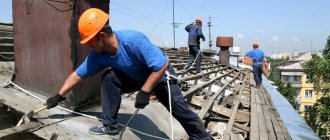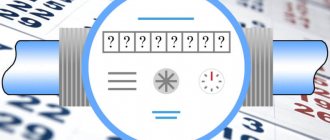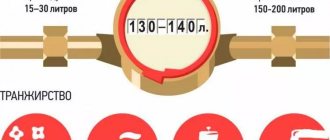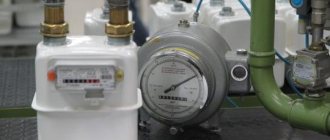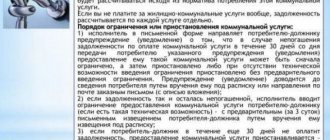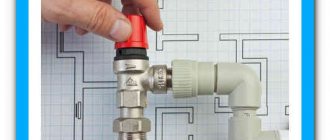Correct operation of metering devices allows you to pay for utilities at a single tariff, so checking water meters on time is a mandatory procedure. The owner of the premises must receive confirmation that the device is operating without violations. To do this, it is necessary to act in accordance with existing rules, which will avoid problems with the management company or resource supplying organization.
Cancellation of water meter verification: truth or myth?
In 2012, the Moscow Government adopted Resolution No. 831, which abolished the inspection regulations that were previously in force on the basis of PPM No. 77 of February 10, 2004. This led to misinterpretation. The fact is that the innovations affected only the period for applying to the state metrological service or an organization that has the appropriate license. Previously, the owner of the premises had to send the DHW meter for verification every 4 years, and the device that controls the cold water supply - every 6 years.
The resolution does not cancel the verification of IPU, so the process remains mandatory. Now the basis is not the approved period, but the calibration interval, which is prescribed by the manufacturer. This allows you to install meters in an apartment or private house with a significant period of initial operation.
Changes in Moscow legislation in the housing and communal services sector have brought the existing provisions into compliance with RF PP No. 354 of 05/06/2011, where the verification interval is determined on the basis of the accompanying documents of the IPU. Any actions of management companies or resource supply organizations aimed at establishing other parameters are contrary to the law.
On a note! The implementation of actions to confirm the operability of the mechanism and its replacement lies entirely with the owner of the premises and is mandatory, guaranteeing the calculation of resources at a single tariff. There are no sanctions or fines for refusal to carry out the procedure, only a change in the form of payment.
Service life of meters: how to find out the calibration interval
Correctly accounting for the period of use of hot and cold water IPU allows you to avoid problems with the management system and unnecessary expenses. Based on the current Decree of the Government of the Russian Federation No. 354, as amended in 2021, the calibration interval is calculated on the basis of the technical documentation (passport) of the meter. The exact period is prescribed by the manufacturer with the appropriate notes.
At the moment, the most common devices are with the following interval:
- For cold water supply – 6 years.
- For hot water supply – 4 years.
- Some foreign manufacturers set a frequency of 10–12 years. Such devices must undergo mandatory testing on the territory of the Russian Federation and receive approval.
When purchasing a new meter, you should pay attention to the date of its release, because it is from this date that the time until the next verification will be counted
A certified meter has State verification seals and a full set of documentation. It is necessary to correctly estimate the time before extending the service interval: this should be based on the factory test date, and not on installation or commissioning of the device.
The service life of the meters during which the equipment can be used is also assessed. For domestic devices it is most often 12 years, for foreign ones – 20–25. Durability is affected by many factors, so the device may become unusable much earlier.
Due to various operating conditions, which do not always correspond to the established ones, the manufacturer determines the warranty period during which claims regarding the operation of the meter are made. It is written in the passport and most often lasts for one and a half years. If the water meter fails or the readings are found to be unreliable during this period, you can request a replacement, but the warranty is valid only if the specified conditions are met.
How long is the testing period for water meters?
How often do you need to check hot and cold water meters, and after how many years does it take place? In past years, the test interval for DHW and cold water devices was different . For the former it was 4 years, and for the latter – 6 years.
A shorter period for checking DHW flow meters was associated with their rapid wear. Hot water passes through such water meters, the environment of which is aggressive for the mechanisms of the devices. They experience a greater negative impact than HVS devices.
In recent years, the approach to determining inter-verification periods for cold water and hot water flow meters has changed. It is installed by special verification instructions under the number LGFI.407223.003 MI.
HVS
For the specified type of water meters, the calibration interval has not changed. It is still 6 years .
This time period is provided for all vane water meters.
It begins to be calculated from the day when the device was initially verified at the manufacturer. This is noted in the device data sheet.
DHW
For this type of water meters, the verification period is now equal to the time period established for cold water flow meters. It is 6 years.
In the technical data sheets for all modern (released after 2015) vane DHW meters, a 6-year verification interval is established .
When may early verification be required?
The need for unscheduled confirmation of the functionality of a water meter may arise for various reasons:
- Damage to control seals (factory or installed during commissioning).
- The appearance of a defect that leads to incorrect readings. This may become apparent with a significant increase in resource consumption.
- Violation of the integrity of the counter. Mechanical impact on the housing may cause external damage. To exclude their influence on performance, it is necessary to double-check.
- Loss of technical documentation or previous reconciliation report. As a result of a change in the owner of the premises, management company, resource supply organization or other reasons, supporting documents may be damaged or lost. To verify the accuracy of the readings, you will need to obtain confirmation.
- Independent decision of the owner of the house or apartment. Based on the results of a scheduled inspection, a management company specialist may indicate that the metering device is operating in violation of the permissible error. In order to confirm serviceability, contacting a certified laboratory is allowed. In some situations, it is advisable to replace the water meter in an apartment or private house with a new one, since an examination can confirm that the device is not working.
The most common reasons for unscheduled verification of a water meter are considered to be a violation of the integrity of the seal and defects in the device body.
Advice! If the device was installed by the former owner of the property, but the necessary documents are missing, then the time of the next performance assessment can be calculated by the date on the IPU body or found out from the receipt.
Where to check the water meter and do you need to pay for it?
The verification procedure is carried out only by special organizations, since the process involves the issuance of permits.
You must contact the following institutions:
- State metrological service. It is administered by Gosstandart.
- Organizations that have received accreditation in the field of ensuring uniformity of measurement. Licensing is carried out by the Federal Accreditation Service.
- Management or resource supply companies, but only with appropriate permission.
- IPU manufacturing plants. Some enterprises provide a re-verification service for issued water meters.
When contacting a non-governmental entity, you must make sure that the institution has all the relevant documents that are valid at the moment.
Verification of the water meter is provided exclusively as a paid service, since the responsibility for providing housing for the IPU lies with the owner. This is reflected in the RF PP No. 354 dated 05/06/2011 (as amended on 03/27/2018).
If you rent housing from the municipality in 2021, the next inspection will be paid for by the administration. You can also receive the service for free by participating in various promotions of organizations or by taking advantage of a special offer. In some regions, special conditions apply for preferential categories of citizens, but to clarify the information, you need to contact the Social Security Administration.
Who pays for checking the communal meter?
The decision whether apartment owners need to pay for diagnostics of a single measuring device always causes a lot of controversy. The procedure is reflected in the Decree of the Government of the Russian Federation dated May 6, 2011 No. 354. Clause 34(e) contains the following instructions:
- If the heat meter is the property of the residents (installed at the expense of the owners, transferred to the balance of the HOA, or installed at the expense of the state, but the payment period has ended), the owners of the premises must pay for the verification.
- If there is an agreement with the utility service provider, which contains a clause that the maintenance of the meter installed in an apartment building is carried out at the expense of the contractor, the owners are exempt from paying money for diagnostics.
If necessary, the amount for the verification procedure is paid in the form of a single targeted contribution or the payment is distributed over a certain period and entered into the receipts.
Verification procedure
Confirmation of the operability of household water meters is carried out according to the standard scheme:
- 2 applications are submitted to the utility service provider. The first is to call a specialist to take the last readings, the second will be required for dismantling, which is carried out by an employee of the management company or resource supplying organization.
- At the appointed time, a specialist will come, take the last meter readings and draw up a report that will reflect all the information. One copy remains with the owner.
- Next, the non-factory seal is removed, the device is removed, and a temporary spacer is installed.
- The owner must hand over the device to an official organization that has the appropriate permission and fill out an application for verification. It is imperative to obtain a report that will reflect the basic data of the water meter. Since the procedure is carried out for a fee, the required amount is paid.
- Verification times vary from several hours to a week. As a result, accompanying documents are issued along with the IPU, the main one of which is a certificate of the examination. If there are no defects, then the mechanism is allowed for further operation.
- Before putting the meter back, you must submit a request to the utility service provider to call a specialist who will put the device into operation.
If the premises are municipally owned, then the work must be coordinated with the administration.
Procedure
After receiving an order from the sales organization or if there is a need for an extraordinary verification, the owner of the residential premises must comply with the following instructions:
- An application is submitted to the utility service provider. It is necessary to invite a specialist to record the final readings and remove the filling.
- The heat energy meter is dismantled. It is important not to disrupt the overall functioning of the system.
- The device, along with accompanying documents, is transferred to a certified laboratory. The mechanism is tested at a special verification facility. Electronic adjustments or battery replacement may be required.
- If the functionality is confirmed, a certificate with seals and holographic stickers is issued.
- An application is written to the management company or sales company. The request indicates the need to put the IPU into operation and seal it. The date and time are being confirmed. Additionally, a certificate of diagnostic testing, a product passport and personal information are attached.
- The meter is being installed in the apartment. The performance of the heating system is assessed (if possible).
- At the appointed time, a specialist arrives to carry out the inspection. If no problems are found, a sealing is performed, for which you do not need to pay.
When the commissioning report is transferred to the service company, the readings are taken into account to calculate the resource consumed.
Sequence of actions when checking the performance of a thermal IPU
Checking the water meter at home without removing it
An alternative option makes it possible to avoid the difficulties of dismantling the IPU. You need to call a specialist, who must have a special calibration device with a certificate of conformity.
Methodology:
- By the time the initial use of the IPU expires, you need to submit an application to the organization that provides the relevant services. When contacting, all information about the meter, including its location, is indicated.
- The arriving specialist should check the supporting documents, after which you can begin work.
- The technician will take several measurements of the amount of water that passes through the meter. Based on the data obtained, the error is calculated.
- If there are no problems, a test certificate is issued indicating that the mechanism is suitable for further use. If malfunctions are detected, the device cannot be used to record water consumption and must be replaced.
When choosing an organization that provides home-based water meter testing services, you need to make sure that the company has a valid license to perform such work, otherwise the documents it issues will not be valid
All documents received must be checked on site to ensure the presence of seals and stamps. It is imperative to obtain confirmation that the tests were carried out by a licensed organization: a service contract may act in this capacity.
Attention! The frequency of verification is not limited, but upon reaching the maximum service life, the meter becomes unusable, so you need to compare the period specified in the passport with a specific time period.
Methodology for checking electricity meters
Once it has been established, based on technical documentation or due to an urgent need, that the time for verification of the electric meter has arrived, it is sent to the standardization and metrology laboratory. There is another option. If the stipulated verification interval expires, specialists will work on site. That is, the subscriber orders the service of visiting experts at home.
In both cases, the expert, after taking measurements, issues a verification certificate. It describes the necessary technical characteristics of the device, established experimentally.
While working with a stationary laboratory stand or remote device, specialists conduct a thorough analysis of the actions of the metering device in various modes:
- how high current and high voltage affect accuracy and serviceability;
- is there any unauthorized movement of the meter to count unused electricity;
- whether the insulation, mechanics and electronics of the device can withstand increased load.
If all parameters are within the specified parameters, testing ends. The sealing is carried out along with the installation or re-sealing is carried out if the work is done at home.
Any type of meter must have two seals - the company that operates the device (energy industry) and the company that carried out the verification (standardization center). Only the presence of these two seals guarantees its safe and legal operation and further absence of claims from power engineers.
How and what marks are made
After the meters go through the full procedure of analyzing the accuracy of accounting for electricity consumption data, marks are affixed. They are entered in writing manually with a stamp and indicating the number of the verification certificate.
The inspection organization makes a mark in the accounting documents and simultaneously enters data into the internal documentation of the company. This is necessary for control and, if necessary, this data can become the basis for issuing duplicate documentation.
Based on the results of the experts’ work, the subscriber is given a separate document - a certificate (certificate) of verification of the metering device. It indicates all the main indicators and confirms the possibility of using the device. The technical statement of suitability for energy consumption measurements confirms its continued safe use.
Is it possible not to remove the electric meter?
Yes, you can order the service to your home. This is one of the options for quickly meeting the requirements for the calibration interval. In Russia, any licensed organization can provide such a service, but it is best to contact government agencies in the field of metrology and standardization. There are many private companies with positive practices in this direction.
By law, the energy supply company is no longer the only one providing this type of service.
In order not to remove the meter and carry out verification legally, you should notify power engineers about it and conclude a service agreement with the performers.
There is no difference between verification in a laboratory or on-site. Neither in legal legality nor in technical accuracy does this assessment of the serviceability of the meter differ. The only difference is the price. For field work, metrologists can charge a significantly higher amount. This is because field work involves paying a specialist to work using transport and portable measuring equipment.
Service cost
Payment for verification services can have a significant range in prices. The maximum amount is paid for an urgent service, that is, when the master arrives, checks and seals everything in 1 calendar day. In this case, the minimum rate increases by 200-250%.
If verification is carried out within 3 working days, the price increases by no more than 40-50%.
The minimum rate for the service of assessing the performance of the meter is 700-800 rubles.
The maximum fee for expert conclusion on complex three-phase devices does not exceed 3.5 - 4 thousand rubles.
The on-site and stationary types of verification to fulfill the conditions of the MPI may practically not differ from each other. The whole point is that it is necessary to calculate all overhead costs: dismantling, installation of the device, its transportation, time for transfer, documentation.
Who pays
State verification is ordered at the expense of the subscriber’s personal funds. This obligation is clearly stated in the text of the Government resolution that regulates the retail electricity market. That is, the meter must not only be purchased, but also actually used by one person - an individual or legal entity. Only when the owner is clear does the obligation arise to carry out verification and protect the device from breaking seals or otherwise compromising the accuracy of accounting.
Some subscribers are in no hurry to delineate responsibility for metering devices. However, during the next inspection, accounting can be transferred to a standard assessment, and the meter will not be used to record consumption data. Therefore, registering meters and assigning ownership is ultimately more beneficial for the subscriber than trying to evade their service.
Where to take documents
If dismantling and subsequent installation were carried out, then it is necessary to obtain a certificate of commissioning of the device. After all the information has been collected, you need to submit the documents to the office of the management company, homeowners association or resource supply company and take confirmation of acceptance. It is recommended that you keep the originals and submit color copies.
The receipt for the next billing period should contain a change in the date of future verification.
It is not always necessary to take the documents to the owner himself: if the work was carried out by a specialist from the utility service provider, then he transmits the information.
What are the consequences of delaying verification?
It is not always possible to confirm the correct functioning of the water meter in a timely manner for various reasons. It is pointless to lie about real readings or hide the fact that the device is malfunctioning, since the utility service provider checks the performance of the device once every six months, which will certainly lead to identifying the problem and drawing up a protocol (report of non-compliance).
Late verification leads to certain consequences:
- Initially, accrual occurs based on the average resource consumption for the previous 6 months. If the meter operated less, then 3 months are taken for the calculation.
- If the owner did not carry out the replacement or did not conduct an examination, then in the future the service will be charged according to the standard. Today, the average consumption of cold water per person is 7 cubic meters, hot water – 5.
- Additionally, a multiplying factor is applied. This is because the device is assessed as missing.
Some management companies and supply companies may charge fines, which is illegal.
On a note! It is never too late to carry out an official verification of the meter’s performance, even if the management company or the supply company has removed the mechanism from the register.
Is it possible to recalculate after an overdue verification?
If the period of initial operation of the meter ends, but confirmation of its operability is not received, then the device is considered out of order, therefore, in the future, increased amounts are charged. This is reflected in the RF PP No. 354 dated 05/06/2011, paragraph 81(12).
After verification, according to the results of which the meter is recognized as suitable for operation, the management company or another organization puts the device into operation. It is from this moment that the readings are taken into account. But for the period during which the mechanism was considered out of order, recalculation is not done, because according to the rules, the IPU is operational only with a valid calibration interval.
Frequency of verification of heat meters
There are several options for confirming correct functioning, which the device can go through at different stages:
- State verification. Mandatory procedure performed at the manufacturing plant. The process is carried out using special equipment. The result is the approval of the mechanism for sale. The heat meter passport is stamped with a date from which the period until the next diagnosis is counted.
- Periodic. After the verification interval has expired, it becomes necessary to conduct another examination, which should confirm the correct operation of the meter. If the procedure is not followed, the IPU will be declared unsuitable for further use.
- Extraordinary. For reasons specified in Government Decree No. 354 or due to other factors, heating meters require verification before the expiration of the MP.
Depending on the model and manufacturer, there are specific deadlines set from factory (primary) to periodic diagnostics. The most common options are:
- House-wide heat meters in an apartment building have a calibration interval of 4 to 8 years. Standard examples: models “KM 5”, “Du(25-50)”, “TEM-104”, “VIS.T”. The period of operation is from 12 to 18 years.
- The calibration interval for apartment heat meters varies - from 4 to 6 years. Service life is from 12 to 18 years. An example is a product of the STK "MARS" brand. Many manufacturers additionally indicate the average period of operation, which is best to focus on.
The number of possible performance reviews depends on the service life.
In the household sector, one of the most popular models is the Mars heat meter; this device successfully combines an affordable price with high quality
Advice! The longer the time period before the next verification, the more profitable it is. This is explained by the payback period, after which real savings begin.
How to check the meter at home
Each co-owner must personally monitor the functioning of individual water meters, and if any malfunctions are detected, immediately notify the utility service provider. If you delay contacting the management company with an indication of the identified problem, then recalculation at an increased rate is possible.
The presence of a defect can be determined as follows:
- Readings of hot and cold water supply meters are taken.
- 10 liters of liquid are drawn into a measuring bucket in a thin stream.
- At medium tap pressure, 100 liters of water are poured sequentially and continuously.
- 1000 liters are consumed and measured. After each action, readings are taken.
- The result is analyzed: the actual water consumption and meter data are assessed. The error is calculated and compared with the information specified in the IPU passport or on the device.
If deviations are identified, it is necessary to carry out an official verification and, if necessary, replace the meter with a new one.
